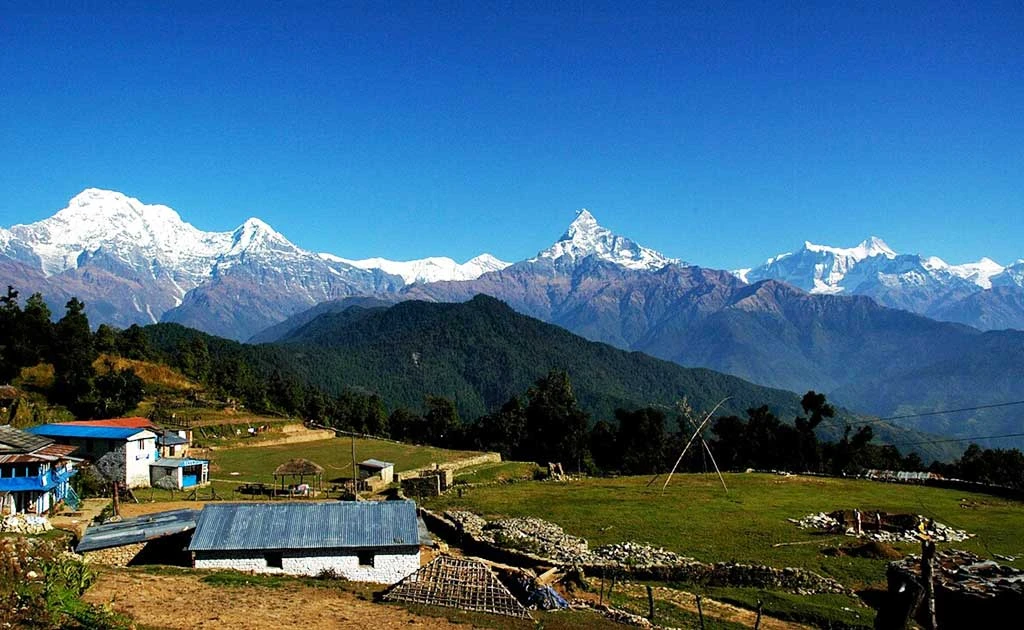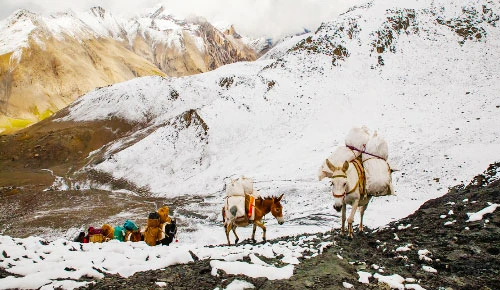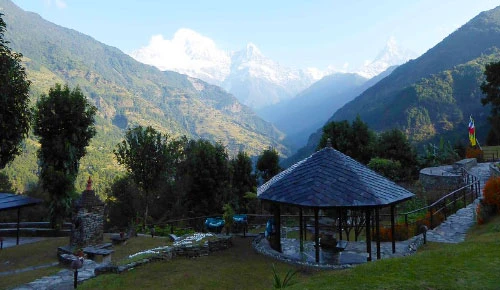Australian Camp Travel Guide
Australian Camp is a small and tranquil settlement compared to the hilltop of the low foothills of the Annapurna region, which has been known as an ordinary stopover among trekkers and day hikers. It is situated at an elevation of 2,060 meters and offers a relaxing experience without requiring days of trekking up a steep hill. The camp promises one of the best short treks in Nepal, as it grants you spectacular 360-degree vistas of the Annapurna south, Hiunchuli, Machhapuchhre (Fishtail) and even the farthest Dhaulagiri region.
The entire Australian camp is very unique. It is not only the view that is there but also the ambience. The hike to arrive here runs through the peaceful forests, stone-paved paths in the village, and fields where you may encounter locals working on their lands. Upon arrival, you are greeted by teahouses at the ridge, the prayer flags waving strongly in the air, and some magical calmness, which just automatically slows you down.
Unlike longer treks leading to higher areas in the Himalayas, the Australian Camp is available to a maximum number of people, including those who have been in the trekking business the longest, as well as families with children or even those short of time. It is an excellent opener to the culture of trekking in Nepal, which combines the views of mountains, understanding the life of villages, and the beauty of nature on a short but unforgettable trip.
Best Season to Visit Australian Camp
Spring (March, May)
This is the most colorful period to visit the Australian Camp. Along this trail are forests, which germinate with wildflowers, rhododendrons, and magnolias. Weather conditions are very favorable, with 15-25°C as the average temperature during the day and cooler, yet very pleasant, nights. Skies are typically clear, and you have obvious views of Annapurna and Machhapuchhre. It is an ideal time of year when nature lovers can seek both the sight of mountains and see rich and lush landscapes.
Autumn (September to November)
Autumn is the most popular trekking season in Nepal, and for good reason. After the monsoon rains, the air turns fresh and the skies clear up, offering some of the clearest and most reliable mountain views of the year. Daytime temperatures hover around 12°C to 20°C, with slightly chilly mornings and evenings. The villages and trails feel lively, and summertime is the best season if you’re looking for a mix of great weather, breathtaking vistas, and a festive atmosphere in Nepal.
Winter (December to February)
If you enjoy quiet trails and a peaceful atmosphere, winter is also a beautiful time to visit. The mountains appear incredibly sharp against the clear blue sky, and the camp itself feels calm and uncrowded. Daytime temperatures stay between 8°C and 15°C, but nights can drop close to 0°C. With warm clothes, it can be a rewarding trip, especially for those who want to avoid the crowds.
Summer/Monsoon (June to August)
Summer brings lush greenery and refreshing landscapes, but it’s also the wettest season. Heavy rain can make the trails slippery, and clouds often cover the mountain views. Temperatures stay warm, around 18°C to 27°C, and if you don’t mind the rain, you’ll enjoy a hushed trekking experience with vibrant, green surroundings.
How to Reach the Australian Camp?
The Australian Camp is relatively easy to visit, making it an accessible trekking point for people of all ages. Typically, the trip begins in Pokhara, easily accessible by air and road from other major cities and nearby cities. In Pokhara, you can take a short 1- or 1.5-hour drive to Kande, where the trek initiates. The road in most cases is good, and you may be using local buses, taxis, or your cars.
The trek starts at Kande, an adventurous uphill route along green forests, little cultivations, and quaint Gurung villages. The trail is medium and easy in difficulty, with an average of 1.5 to 2 hours to complete; hence, it fits first-timers in the park, families, and those seeking a half-day hike. On the journey you will have the fresh mountain air, birds chirping, and the views of Annapurna South and Machhapuchhre at times.
Some of the hikers will consider extending the trail alongside Australian Camp to nearby villages such as Dhampus or Pothana; the extension is natural and allows even more time in the mountains without having to worry about transport logistics. It could also be an early morning start by 6 AM in Pokhara, and you may return the same day, but it is advisable that a night should be allocated to really enjoy the ridge throughout the sunset and early morning with the sun.
Food and Accommodation at Australian Camp
The stay at Australian Camp is very basic but comfortable, and the cozy teahouses with small lodges are managed by local families. The lodging is simple yet cozy and includes mostly clean rooms with twin beds, comfortable blankets, and shared facilities. Although no luxury hotels are located here, the beauty is in the old-school mountain hospitality, which is exemplified by the fact that the owners tend to greet you with a smile, a cup of hot tea, and some interesting stories to tell about the area. Most lodges also offer common dining rooms or terraces, where you may sit and have a hot drink while enjoying the panoramic views of the Annapurna and Machhapuchhre mountains. It is advisable to make reservations during the peak seasons of spring and autumn because the few lodges are highly likely to be fully occupied.
Australian Camp uses the standard Nepalese trekking menu when it comes to food, and it serves local as well as international cuisine. Their staple is Dal Bhat, which is a nutritious Nepali meal comprising rice, lentil soup, vegetables, and pickles that constitutes the right amount of energy to go trekking. To mix things up, there are noodles, fried rice, pasta, soups, momos (dumplings), and pancakes as well. During breakfast, tourists normally have porridge, eggs, bread, or Tibetan bread with honey or jam. Hot beverages such as tea, coffee, and ginger lemon honey are easily acquired here.
The atmosphere, not just the food, adds to the specialness of dining here. The feeling of having a warm meal with a view of the snow-covered Himalayan range or the warmth of a fireplace with fellow trekkers in a warm room is an unforgettable one. The menu may be limited, but the experience of freshness and hospitality makes up for it. A night's stay at Australian Camp offers you the chance to enjoy hearty meals, experience the chilled mountain atmosphere, and either continue your trek or return to Pokhara.
Major Attractions at the Australian Camp
- The scenic views include Annapurna South, Machhapuchhre (also known as Fishtail), and Dhaulagiri.
- The sunset and sunrise locations across the mountains are truly amazing.
- There are dense forests of rhododendron, pine, and oaks.
- Stone houses and prayer flags are low-rise villages of Gurung people, such as Dhampus.property
- The hiking trails are completely free of traffic, have minimal elevation, and are completely peaceful.
- Bird watching in the adjacent forests
- At every corner are scenic photography points.
- Teahouses have relaxation terraces with mountain views.
- The place offers sweeping valley views that overlook the town of Pokhara and Phewa Lake.
- Wildflowers in the spring season add color to the trails.
- Engage with the local culture during festivals or in everyday life.
- Scenic backdrop picnic areas along the path.
- Light trekking into the gentle hills to Dhampus and/or Pothana.
Things to Do in Australian Camp of Nepal
Trek from Kande to Australian Camp
The walk by Kande to Australian Camp is an easy and pleasant path that passes through some thick forest, terraced farmland, and tiny villages. Trekkers can see the Annapurna range and Machhapuchhre through it, and the mountain air surrounds all the walks. This trail is perfect in the sense that it is suitable for beginners and families because it provides a feel of Himalayan trekking without the fatigue of a big journey. It is also good to visit local agricultural techniques and see how villagers live in peace with nature.
Walk to Dhampus Village
A small hike away (approximately 45 mins) will bring the person to the second adorable village, Dhampus, a Gurung village in the Australian camp. Travelers will be able to visit stone row houses, take pictures of colorful prayer flags swinging in the air, and communicate with locals to figure out what their way of life and culture are. The village is a glimpse of real mountain life, such as agriculture and cooking of different sorts, as well as social events. One can spend several hours here, which will present an intensive cultural immersion that supports the natural beauty of the region.
Witness Sunrise and Sunset
The spectacular view of sunset and sunrise is one of the best aspects of Australian Camp. The sun rises early in the morning and bathes the Annapurna and Machhapuchhre peaks in a golden halo, a picture-perfect moment to be sure, which is also a good opportunity to take some photographs or get lost with some personal thoughts. The same spectacle is witnessed in the evenings, with the sky filled with pink, orange and purple colors and showing off against the mountains with their crowns covered with snow. Through these, we get a bit of tranquility and unity with nature, which can hardly be achieved elsewhere.
Relax at Teahouse Terraces
The Australian Camp has many teahouses with terraces overlooking rivers and the mountainside and valleys beneath. A cup of tea or coffee on these terraces is a relaxing experience to take in the surroundings. Travelers will be able to read, write, or just watch clouds move across faraway sounds of the forest, and the village life is soothing. The terraces are also great places for socializing, allowing you to gather with other trekkers and exchange stories about the trail.
Nature Walks
Forests on the sides of the Kathmandu valley are full of rhododendrons, pines, oaks and other Himalayan plants, and every short walk is a pleasure to nature lovers. Trekkers will be able to walk through less-traveled paths, find obscure panoramas, and watch birds. During the spring, the actively growing flowers line the trails and bring another burst of colors to an already picturesque background. Even a small walk will provide a welcome change and allow for close contact with nature.
Photography Opportunities
Australian Camp is a dream to every photographer. Each corner has something new to experience—sweeping views of the Himalayas and terraced fields of the farms, traditional rural villages, and forest trails. The magic lighting of landscape shots occurs at sunrise, sunset, and even on misty mornings. They are also able to capture cultural moments, such as local people doing their daily chores or children playing or placing offerings into the ceremonial display, which adds more depth and diversity to their collection of travel photos.
Bird and Wildlife Watching
The forests around Australian Camp host various Himalayan birds, including colorful species that are a treat for birdwatchers. Along the trails, trekkers may spot small mammals, butterflies, and other wildlife, providing opportunities for nature observation and ecotourism. Quiet mornings and evenings are the best times for wildlife spotting, when the forest comes alive with the sounds and movements of its inhabitants.
Available Packages
For those wanting to explore Australian Camp as part of a longer adventure, Nepal Trek Adventure offers:
The above listed trek passes through Australian Camp, giving trekkers the chance to enjoy its stunning Himalayan views, peaceful forests, and traditional Gurung villages. It’s the perfect way to combine a short, scenic hike with a more challenging, rewarding trek up to Mardi Himal Base Camp.The package includes experienced guides, comfortable accommodations, meals, and well-planned logistics, ensuring you can focus on the scenery and experience rather than the details of planning. Whether it’s your first trek in Nepal or you’re returning for a more immersive Himalayan journey, the Mardi Himal Trek through Australian Camp provides a memorable combination of natural beauty, cultural exposure, and adventure.
Final Words
Australian Camp is not merely a lookout; it is their escape into nature, where the distance to the mountains is perfectly balanced with the mountain feel. This is a popular spot since it is within reach of most individuals despite their age group and fitness levels as compared to the challenging high-altitude treks. Its calm surroundings, along with dramatic views of the Himalayas, create a perfect space to visit in search of a short but fulfilling trip to the Himalayas. It does not matter whether you are on a day, weekend or long trip in the Annapurna region; what matters is that once you come to the camp, you will leave with moments of serenity, cultural experience and fantastic natural surroundings.




